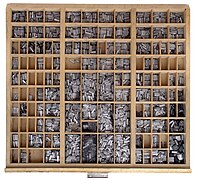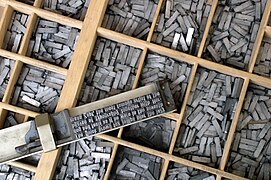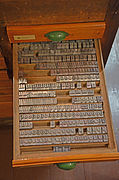Type case
The display case is in the Handsetzerei used sorting box for letters in lead type .
A display case contains one and only types of the same font , font size and font style . In addition to the characters, the box also contains non-printing material, the dummy material , consisting of squares , quarters and spaces for the spacing between words and characters. It should not contain “fish” ( letters mistakenly placed in the wrong compartment of the box) or onion fish (letters mistakenly placed incorrectly from a different font or face). The size of the compartments and the arrangement of the types in them depend on the average frequency with which certain types are used in the text. Therefore, the arrangement and characteristics differ depending on the language area. In Germany , the classification is now based on DIN 16502 . The antique case has 125 compartments, the size of which depends on the frequency of use. There are eleven whole subjects (e.g. for e and n ), 40 half subjects (e.g. for h and l ) and 72 quarter subjects (e.g. for numbers). In addition, a third (one-point space ) and a two-thirds (letter i ). This division applies to fonts in groups I – VI according to DIN 16518 for font classification. In the case of the boxes for broken fonts, the accented letters are omitted and there are 21 quarter compartments for reserve letters or in group X for ligatures . The boxes for fonts in groups VII – IX and XI often do not adhere to the standard allocation. The number of compartments can be reduced to 116.
The font boxes are also differentiated in size:
- Bread letter box or large letter box approx. 96 cm wide, 61 cm deep and 5.2 cm high,
- Standard box or small lettering box approx. 66 cm wide, 61 cm deep and 4.3 cm high,
- Titling box also plug-type holder with a 27 cm width, 61 cm (rarely 45 cm depth) and 4.3 cm box height (in these cases, the letters are not usually stored in individual letters compartments, but inserted in alphabetical order in series).
A good typesetter can type around 1200 to 1500 letters per hour from a bread box. The “productivity” of a typesetter is reduced, however, if one takes into account the additional time that he needs to “deposit” the lead type back into the type case after printing.
Due to the almost complete abandonment of metal typesetting and the conversion to new printing techniques , most of the typesetting cases were decommissioned. Preserved specimens are now used by collectors to store and display small items. For this purpose, replicas are also referred to as "type cases", but they usually differ considerably from the real type cases.
A type case is also a teaching aid invented by Johann von Hermann in 1835 , which is still used in elementary language lessons today: a box that contains the individual letters on cardboard or plastic plates several times, with a device in which these letters become words can be plugged together.
- gallery
Type case with angled hook
literature
- Printing . In: Meyers Großes Konversations-Lexikon . 6th edition. Volume 3, Bibliographisches Institut, Leipzig / Vienna 1905, pp. 528-532 .
- Sepp Dußler, Fritz Kolling: Modern typesetting . 4th edition. Verlag Documentation Saur KG, Pullach 1974, ISBN 3-7940-8703-8 .
- Eberhard Dilba: Typography-Lexicon and Reader for All, 2nd Edition, Books on Demand, Norderstedt 2008, ISBN 978-3-8334-2522-6 .







